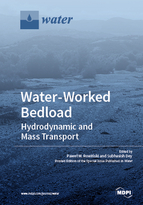Water-Worked Bedload: Hydrodynamic and Mass Transport
A special issue of Water (ISSN 2073-4441). This special issue belongs to the section "Hydraulics and Hydrodynamics".
Deadline for manuscript submissions: closed (29 March 2019) | Viewed by 36257
Special Issue Editors
Interests: mathematical modelling of hydrological processes; fluvial hydraulics; river turbulence; pollution; heat and sediment transport in rivers
Special Issue Information
Dear Colleagues,
Flow over a streambed that is complex in nature, especially in the near-bed flow zone, has been a topic of continued research interest over several decades due to its practical importance. It is even more complicated due to flow unsteadiness that intensifies transport processes and causes morphological changes in rivers. Our knowledge on how sediment is transported under unsteady flow conditions is still insufficient, which triggers a good deal of experimental, theoretical and computational efforts. The near-bed flow is greatly influenced by a complex, colossal fluid-sediment interaction which gives rise to a spatial flow heterogeneity in addition to an enhanced temporal intermittency in the near-bed flow zone. In a natural river, the flow velocity plays a major role in developing the bed surface topography formed by the roughness elements. To be specific, the sediment particles at the bed surface are in motion if the flow velocity is greater than the threshold velocity of sediment particle motion. Thus, the surface topography of a natural bed exhibits a spatially multifaceted three-dimensional organization, because it is created by the transport processes as a result of the continual deposition and reworking due to fluvial processes. In this way, a so-called water-worked bed is formed in a natural river. On the other hand, in laboratory experimental studies, a simulated streambed is generally prepared depositing randomly mixed sediments to a given thickness into the experimental flume. The streambed surface is then scraped and levelled, forming a screeded bed. Nevertheless, in the laboratory, if the distribution of scaled sediment size is at par with the natural bed sediment size (prototype), the simulated streambed can be deemed acceptable provided that the bed surface characteristics in laboratory flume are analogous to those in the prototype. To be specific, the screeded bed is essentially a mixture of randomly sorted sediments and its statistical distributions in terms of bed surface topography are unable to appropriately represent a water-worked bed, even though the bed surface formed by the sediment has a same particle size distribution. Importantly, the signature of the bed roughness characteristics is essentially transmitted to the characteristics of the time-averaged flow, turbulence parameters and resistance to flow.
Prof. Paweł M. Rowiński
Prof. Subhasish Dey
Guest Editors
Manuscript Submission Information
Manuscripts should be submitted online at www.mdpi.com by registering and logging in to this website. Once you are registered, click here to go to the submission form. Manuscripts can be submitted until the deadline. All submissions that pass pre-check are peer-reviewed. Accepted papers will be published continuously in the journal (as soon as accepted) and will be listed together on the special issue website. Research articles, review articles as well as short communications are invited. For planned papers, a title and short abstract (about 100 words) can be sent to the Editorial Office for announcement on this website.
Submitted manuscripts should not have been published previously, nor be under consideration for publication elsewhere (except conference proceedings papers). All manuscripts are thoroughly refereed through a single-blind peer-review process. A guide for authors and other relevant information for submission of manuscripts is available on the Instructions for Authors page. Water is an international peer-reviewed open access semimonthly journal published by MDPI.
Please visit the Instructions for Authors page before submitting a manuscript. The Article Processing Charge (APC) for publication in this open access journal is 2600 CHF (Swiss Francs). Submitted papers should be well formatted and use good English. Authors may use MDPI's English editing service prior to publication or during author revisions.
Keywords
- bedload
- bed shear stress
- bed surface topography
- fluvial hydraulics
- streambed hydrodynamics
- sediment transport
- turbulence
- water-worked bed







